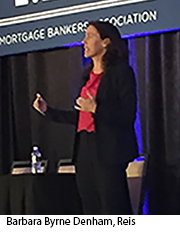
The Economy Has Room to Grow, Says MBA’s Woodwell
PHOENIX–The current economic expansion is growing slower than recently, but it still has room to grow, MBA Vice President of Commercial Real Estate Research Jamie Woodwell said here at the MBA Commercial/Multifamily Servicing and Technology Conference.
Woodwell noted U.S. gross domestic product grew at an 0.7 percent seasonally adjusted annual rate in the first quarter as the unemployment rate fell to 4.4 percent.
“Another thing driving the economy is household growth,” Woodwell said. “Household growth drives a lot of consumption.” He said between 1995 and 2005 all household growth in the U.S. was in owner-occupied households. Then from 2005 to the present, the exact opposite took place: all growth was in renter-occupied households.
“In the first quarter, we saw good positive household growth compared to a year before, about two-thirds was in owner-occupied and one-third was in renter-occupied housing,” Woodwell said. “So we’re seeing some stability. That’s pretty good news. It brings a little bit of relief to some of the excess demands we have seen in the multifamily market and it brings some security to the homeownership market.”
Woodwell said the next 10 years could see some of the strongest household growth the U.S. has ever seen, in part because the Millennial generation often delays until age 35 things that prior generations used to do at age 25–things such as buying a first home. “That means a longer renting period for many people,” he said. “Millennials are doing more later.”
 Barbara Byrne Denham, Senior Economist with Reis, New York, noted that multifamily effective rent growth averaged just 0.2 percent in the first quarter. “That’s a drop, but not a surprise,” she said. “We knew new construction was coming on the market. We see rent growth staying positive but very, very low going forward.”
Barbara Byrne Denham, Senior Economist with Reis, New York, noted that multifamily effective rent growth averaged just 0.2 percent in the first quarter. “That’s a drop, but not a surprise,” she said. “We knew new construction was coming on the market. We see rent growth staying positive but very, very low going forward.”
Byrne Denham also noted less than stellar office net absorption. “In prior recessions we didn’t shed enough space per lost employee,” she said. “Office occupiers can’t just cut their lease. So we had ‘shadow space’ where firms were still paying rent but not fully occupied with employees. Thus we were adding jobs but not a lot of leasing activity. In 2014 that started to change.”
But Byrne Denham noted other changes affecting the office market, too. “Millennials are willing to work in less space than other generations and more people are working from home, so less office space is needed,” she said. “Low square footage per employee–about 100 square feet per person–is here to stay.” She called the office market stable and healthy, “but it’s not going to be robust.”
Woodwell said several recent popular media stories reported that online shopping is “killing” retailers. “But if you pull it out across sectors, retailers are doing pretty well,” he said. “As the housing market has gotten stronger, we’ve seen stores like building materials doing well for example.”
Though some other retail sectors are not doing nearly as well as building materials, it is a mistake to paint all retailers with a broad brush, Woodwell said.
“Believe it or not, retail is not that bad,” Byrne Denham said. “We’re seeing losses in a number of metros but not across country, only in a handful of metros.”
Byrne Denham said most retailers “are still doing pretty well,” especially in larger markets. “It’s mostly the tertiary markets where there are problems. Their growth rate is slow. [But overall] the demand-supply balance is pretty consistent. That’s been healthy. That is why asking rents have not declined.”
Though some analysts express concern about the “wave of maturities” of 2006 and 2007-vintage 10-year loans, “for a good bunch of those loans there was some amortization and some prepayments, so by the time the loans matured in 2016 and 2017, loan balances were lower than expected,” Woodwell said. “The amount maturing this year is roughly equal to what matured in 2010. We’re seeing those loans paying off and paying down as we go along.”
Looking ahead, Woodwell said he always thinks about how things looked when a loan was made compared to today. “If conditions have improved, that’s good news for that loan; if conditions have deteriorated, that can make it tight,” he said. “There’s a pretty positive story for today compared to 10 years ago. Lower interest rates give a significant tailwind. If you think about where property income and net operating incomes are–especially for apartments–they are up more than 50 percent compared to a decade ago, boosting where financing of those properties can be.”
